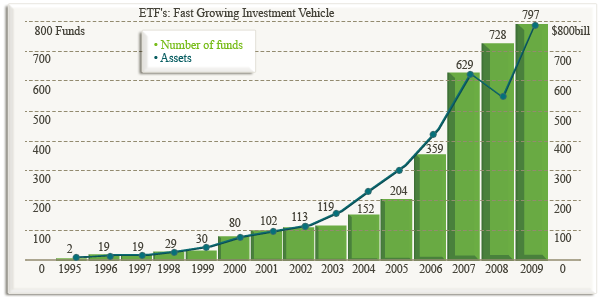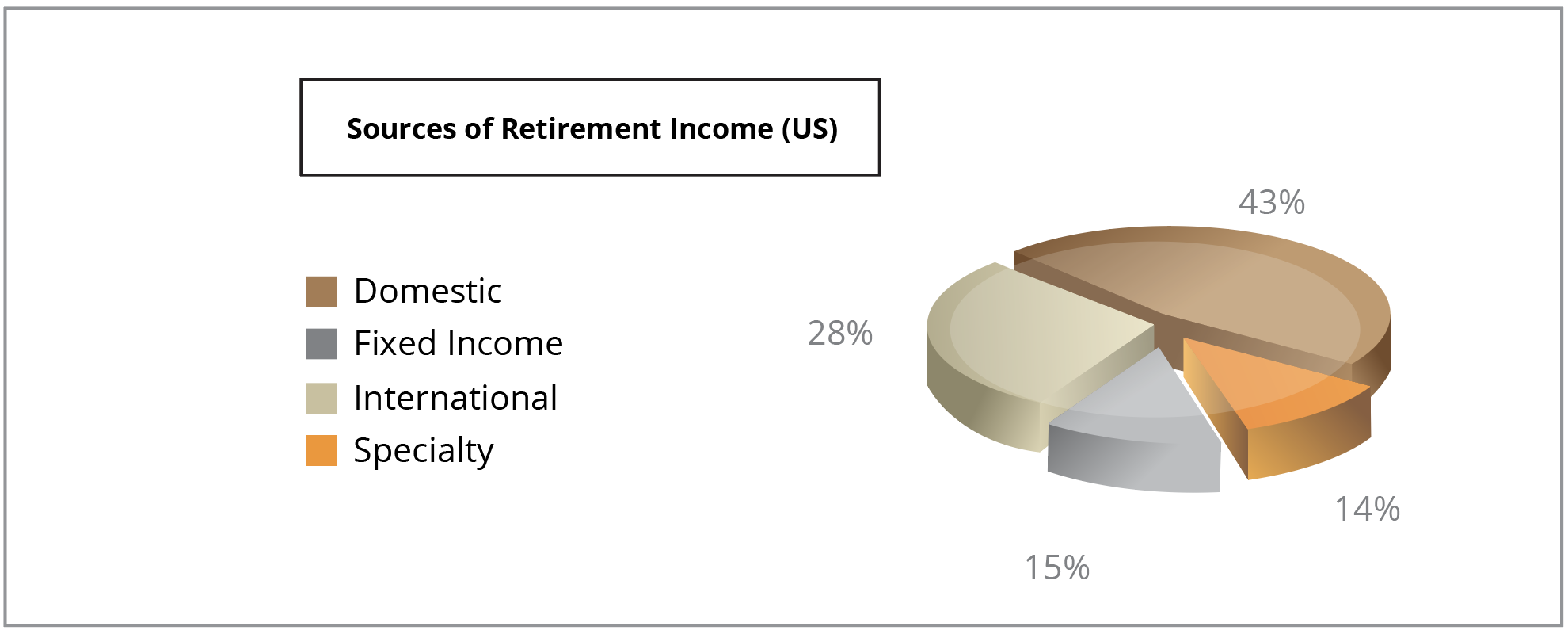Our trading desk is a one-stop resource for obtaining detailed information on nearly 600 ETFs including comprehensive profiles of each fund, performance, holdings, news and expense information.
An Exchange-Traded Fund ("ETF") is an investment fund traded on stock exchanges. An ETF holds assets such as stocks, commodities, or bonds and trades at approximately the same price as the net asset value of its underlying assets over the course of the trading day. Most ETFs track an index, such as the S&P 500 or MSCI EAFE.
ETFs are a popular investment choice among both active and passive investors. The U.S. market accounts for the largest volume of ETFs in the world. The image below illustrates the increase in the number and total assets of exchange-traded funds from 1995 to 2009.

Source: StateTrust’s analysis of Morningstar data. Performance shown is not indicative of the performance of any specific investment. An investor cannot invest in an index, such as the one these graphs are based on. Past returns are no guarantee of future performance. These returns are based on historical information, from sources believed to be reliable, but accuracy cannot be guaranteed, and these returns can vary in future time periods.
Advantages of ETFs
ETFs generally provide the diversification*, low expense ratios, and tax efficiency of index funds, while still maintaining all the features of ordinary stock, such as limit orders, short selling, and options. Because ETFs have lower costs and can easily be bought and sold, some investors invest in ETF shares as a long-term investment for asset allocation purposes, while other investors trade ETF shares frequently to implement market timing investment strategies.
Among the advantages of ETFs are the following:
- Lower costs - ETFs generally have lower costs than other investment products because most ETFs are not actively managed and because ETFs are insulated from the costs of having to buy and sell securities to accommodate shareholder purchases and redemptions. ETFs typically have lower marketing, distribution and accounting expenses.
- Buying and selling flexibility - ETFs can be bought and sold at current market prices any time during the trading day, unlike mutual funds and unit investment trusts which can only be traded at the end of the trading day. As publicly traded securities, ETF shares can be purchased on margin and sold short, enabling the use of hedging strategies, and traded using stop orders and limit orders, which allow investors to specify the price points at which they are willing to trade.
- Tax efficiency - ETFs generate relatively low capital gains because they typically have a low turnover of their portfolio securities. While this is an advantage they share with other index funds, their tax efficiency is further enhanced because they do not have to sell securities to meet investor redemptions.
- Market exposure and diversification* - ETFs provide an economical way to rebalance portfolio allocations and to "equitize" cash by investing it quickly. An index ETF inherently provides diversification* across an entire index. ETFs offer exposure to a diverse variety of markets, including broad-based indexes, broad-based international and country-specific indexes, industry sector-specific indexes, bond indexes, and commodities.
- Transparency - ETFs, whether index funds or actively managed, have transparent portfolios and are priced at frequent intervals throughout the trading day.
* Diversification does not guarantee a profit or ensure against loss.
Types of ETFs
| Term | Description |
|---|---|
| Index ETFs | Most ETFs are index funds that hold securities and attempt to replicate the performance of a stock market index. An index fund seeks to track the performance of an index by holding in its portfolio either the contents of the index or a representative sample of the securities in the index. |
| Commodity ETFs | Are funds that invest in commodities such as precious metals and futures. |
| Bond ETFs | Exchange-traded funds that invest in bonds. |
| Currency ETFs | Funds are total return products where the investor gets access to the FX spot change, local institutional interest rates and a collateral yield |
| Leveraged ETFs | Leveraged Exchange-Traded Funds (LETFs), or simply leveraged ETFs, are a special type of ETF that attempt to achieve returns that are more sensitive to market movements than non-leveraged ETFs. Leveraged index ETFs are often marketed as bull or bear funds. |
ETF Market Coverage
The following image illustrates the worldwide market coverage of ETFs, measured by Assets, as of December 2009.

Risk Factors of ETFs
Investors in ETF funds may face many different forms of risk depending on the kinds of ETF investments they choose. While the benefits of diversification* from ETFs may lower the downside risk of a single security, it is important to understand that the value of an ETF may decline due to factors affecting the underlying index.
- Market Risk - Stocks tracked by an ETF are subject to the same risks as traditional equities. The market prices for ETFs fluctuate in the same manner as stocks on a daily basis. These fluctuations may be a result of economic conditions, investor sentiment, or security specific factors.
- Credit Risk - Credit risk arises from the uncertainty in a counterparty's ability to meet its obligations. For example, the value and ability of ETF funds to pay dividends may be compromised if the issuer is unable to make payments of principal and interest.
- Interest Rate Risk - Fixed income ETFs are subject to fluctuations in the interest-rate environment. The prices of bond securities tend to rise with a decline in interest rates and vice versa. ETFs that track fixed-income securities are exposed to such changes in interest rates. Typically, there is greater price volatility associated with bonds with a longer maturity.
- Currency Risk - International ETFs are subject to risk of capital loss due to currency fluctuations and a country's economic factors. Currency exchange can affect the returns of a foreign security because foreign exchange rates constantly fluctuate with changes in the supply and demand of each country's currency. Thus, returns achieved by local investors are often quite different from the returns that U.S. investors achieve—even though both may be investing in the same security.
- Political & Regulatory Risks - Changes in regulatory environment or political stability can influence the performance of foreign securities held by ETFs.
* Diversification does not guarantee a profit or ensure against loss.